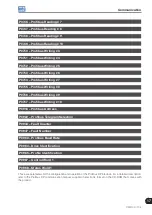
19
Applications
19-4 | CFW700
19.2.2 PID Operation
Before doing a detailed description of the parameters related to this function, a step by step guide for putting the
PID into operation will be presented.
NOTE!
In order that the PID function works properly, it is fundamental to verify if the inverter is configured
correctly to drive the motor at the desired speed. Therefore, verify the following settings:
Torque boost (P0136 and P0137) and slip compensation (P0138), if it were in the V/f control mode.
Having run the self-tuning if it were in the vector mode.
Acceleration and deceleration ramps (P0100 to P0103) and current limit (P0135 for V/f and VVW
control, or P0169/P0170 for vector control).
Setting up the PID Regulador Application
1. Selecting the application:
When the PID Regulator application is enabled, setting P1003 = 1, the default applicative is loaded in the
SoftPLC function, making it available for use in the CFW700.
2. Setting the digital input for the Manual/Auto command:
It is necessary to define one digital input for the Manual/Auto command of the PID regulator. In order to do
that, one of the DI parameters selection (P0263 to P0270) should be set to 20 = Function 1 of the Application.
Recommendation: set the DI3 (P0265 = 20) to do the Manual/Auto command.
3. Setting the analog input of the PID feedback:
The PID feedback (process variable measurement) is always done via one of the analog inputs by programming
parameters P0231 (AI1) or P0236 (AI12) to 6 = Function 2 of the Application.
The AI2 (P0236 = 6) will be selected in this guide.
4. Setting the PID feedback scale:
The transducer (sensor) to be used for the process variable feedback must have a full scale value of at least
1.1 times the highest value to be controlled.
Example: If it is necessary to control a pressure of 20 bar, the sensor to be chosen should have a full scale value
of at least 22 bar (1.1 x 20).
Once the sensor is chosen, the type of signal to be read at the input must be selected (current or voltage) and
the corresponding dip-switch (S1.1 or S1.2) must be set accordingly.
In this guide, a 4-20 mA sensor signal will be chosen (set P0238 = 1 and S1.1 = ON).
Then, the gain (P0237) and offset (P0239) of the feedback signal can be set for adjusting the process variable.
If an offset adjustment is needed, the parameter P0239 must be set according to the detailed description presented
on
After setting the PID feedback scale, the parameter P1018 will be displayed in the “wxy.z” format. This value
corresponds to 100.0 % of analog input, with 1.000 gain (P0237) and 0.00 % offset (P0239) corresponding to
10 V / 20 mA.
Example: If the sensor range is 0-25 bar, set P1018 to 25.0, P0237 to 1.000 and P0239 to 0.00 %, so that when
the analog input value is 100.0 %, P1012 will present 25.0. The “bar” engineering unit is not in the list of available
units, therefore, it is not possible to show it on the keypad.
Summary of Contents for CFW700
Page 2: ......
Page 4: ......
Page 8: ...Summary...
Page 34: ...2 General Information 2 4 CFW700...
Page 38: ...3 About the CFW700 3 4 CFW700...
Page 56: ...7 Starting up and Settings 7 4 CFW700...
Page 58: ...8 Available Control Types 8 2 CFW700...
Page 78: ...10 VVW Control 10 8 CFW700...
Page 158: ...13 Digital and Analog Inputs and Outputs 13 28 CFW700...






























